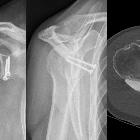CT-Arthrographie






A CT arthrogram is a CT performed after a joint is injected with a solution containing iodinated contrast. They are not commonly abbreviated to CTA, which will be confused with CT angiography. An arthrogram also refers to the procedure of injecting a joint.
Indications
- shoulder - instability/ glenoid bone loss.
- any joint - if MRI is contra-indication and assessment of intra-articular structures is required.
Contra-indications
Absolute
- anaphylaxis to contrast medium/ injectates
- body habitus too large for CT
- pregnancy
Relative
- bleeding diathesis
- recent CT detailing bony anatomy
- recent MR arthrogram
- unable to remain still for the procedure
- surgical hardware
Procedure
The arthrogram injection’s aim is to distend the joint with an iodinated contrast containing solution, but not so distended to cause discomfort.
Preprocedural evaluation
Relevant imaging should be reviewed and details of the patient confirmed. The patient should have an opportunity to discuss the risks and benefits and consent obtained.
Risks include
- infection
- bleeding
- allergy
Driving is not advised after any injection, particularly if local anesthetic is used. The reasons include an inability to perform an emergency procedure and be in safe control of a vehicle.
Technique
Patient positioning and technique will vary depending on the joint, method of access and individual performing the injection .
Steps of an arthrogram injection
- check for allergies and if on blood thinners
- consent
- optimize patient positioning
- optimize imaging and mark skin
- clean skin and draw up appropriate medications
- local anesthesia along the needle track
- obtain joint access with image guidance
- confirm an intra-articular position
- administer CT arthrogram injectate
- apply dressing/ band-aid
The shoulder is the most commonly performed CT arthrogram. A glenohumeral joint injection can either utilize anterior or posterior approaches.
Equipment
- skin marker and a metal rod for marking (fluoroscopy)
- ultrasound machine and sterile probe cover (ultrasound)
- skin cleaning product
- sterile drape
- sterile field and tray for sharps
- syringe selection
- larger bore drawing up needle/ quill
- needle to administer local anesthetic i.e. 25 gauge needle
- needle to cannulate the joint i.e. 22 gauge Quincke needle
- short extension tubing
- injectants i.e local anesthetic, saline, iodinated contrast
- sterile gauze
- adhesive dressing
Syringe selection
The solutions used in CT arthrogram injections are clear, therefore syringe selection is an important way of identifying each solution.
Suggested syringe selection for fluoroscopic CT arthrogram injections -
- 5 mL syringe: local anesthetic i.e. 1% lidocaine
- 10 mL syringe: non-ionic iodinated contrast i.e. iohexol
- 20 mL syringe: arthrogram injectate
Suggested syringe selection for ultrasound-guided CT arthrogram injections -
- 5 mL syringe: local anesthetic i.e. 1% lidocaine
- 20 mL syringe: arthrogram injectate
Arthrogram injectate
If performing ultrasound-guided injections, an intra-articular position is confirmed with direct visualization, therefore the 10mL syringe is not required. Iodinated contrast is still required, differing from an ultrasound-guided MR arthrogram injection. A suggested CT arthrogram injectate mixture for both fluoroscopy and ultrasound-guided procedures is offered below.
- 20mL syringe containing: 10 mL iohexol 300, 5 mL 0.9% saline, 5 mL 0.5% ropivacaine
There are reported chondrotoxic effects of local anesthetics, and intra-articular lidocaine should be avoided. Other lower strength local anesthetics are reported as having less of a chondrotoxic effect. i.e. ropivacaine . Some institutions will not use a local anesthetic in their arthrogram injectate mixtures citing the above, however, its use has been shown to improve comfort and lessen movement artifact .
CT arthrogram requests
Request forms will be sent asking for imaging and it is implied a guided injection will take place before cross-sectional imaging. Waiting times are often longer for arthrograms and they involve an invasive procedure, therefore stricter guidelines for arthrogram imaging are usually in place. CT arthrograms can be excellent studies to assess intra-articular pathologies, in particular when MRI is contraindicated, for example, non-MRI compatible pacemakers, body habitus or claustrophobia.
CT arthrogram imaging
Iodinated contrast is a high density of CT. Intra-articular injection of iodinated contrast will distend the joint and differentiate the low-density intra-articular structures such as the glenohumeral labrum or knee meniscus. Glenoid bone loss is an important image finding in shoulder instability and identification of this will change the surgical approach.
Siehe auch:

 Assoziationen und Differentialdiagnosen zu CT-Arthrographie:
Assoziationen und Differentialdiagnosen zu CT-Arthrographie:

